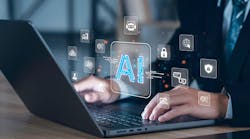ABB and Microsoft partner to advance industrial generative AI
ABB and Microsoft signed a collaboration agreement in 2023, expanding their long-time partnership for the development of generative artificial intelligence (AI) technology for industry. They expect to roll-out new products this year, combining the capabilities of ABB’s Ability Genix and Microsoft’s OpenAI. Vinod Ninan, product director for IoT platform suite at ABB Process Automation, outlines the ways artificial intelligence (AI), machine learning (ML), and generative AI (GenAI) will influence manufacturing in the future.
Collaboration aims to help users minimize unplanned downtime and extend asset lifespans
ABB and Microsoft have been collaborating for several years in the deployment and development of integrated industrial IoT solutions, artificial intelligence, machine learning and visualization technologies. Now, the two are integrating generative AI capabilities for a more intuitive user interaction with ABB Ability Genix Industrial Analytics and AI Suite and applications, leveraging Microsoft’s Azure OpenAI Service. The new application Genix Copilot will provide industry executives, functional specialists, and shop floor engineers with real-time production insights. ABB predicts these insights have the potential to extend asset lifespan by up to 20% and minimize unplanned downtime by up to 60%.
In addition to AzureOpenAI Service, Microsoft will leverage Azure ML services, a cloud-based service for building, training, and deploying machine learning models. “Genix AI services leverages Azure ML services for identifying anomalous operating conditions and predicting failure of specific assets,” Ninan says. Microsoft’s Azure Cognitive Services provides application programming interfaces (APIs) that allow developers to easily add AI capabilities to their applications. Microsoft’s BOT services are used to develop, deploy and manage chatbots or conversational agents. “Genix services is not yet using any of the BOT services but has the capability to use it,” Ninan says. Microsoft’s Power Platform AI builder allows low-code developers to create serverless workflows with Azure functions. “It can be used to integrate OpenAI services into Power Platform applications without extensive coding,” he adds.
Genix also includes industry specific data models for ABB’s core industries, including energy (oil and gas, refinery and water) and process (mining, pulp and paper, and metals) industries. “Using these data models, multiple applications are being built including asset performance management, operational intelligence, overall equipment effectiveness,” Ninan says.
Ninan says that Genix harnesses the power of Model Fabric, a comprehensive suite of AI services and tools encompassing Exploration, Recommender to deliver analytics solutions for complex industry challenges. “The integration of Genix Co-pilot further enhances this capability, empowering plant operators and process engineers with advanced tools for dynamic decision-making,” he adds.
What is prompt-based engineering, and how is AI pivoting in that direction?
Beyond asset performance management, ABB sees potential for GenAI in key focus business areas: sustainability, operational excellence, process performance management, cybersecurity and extended automation.
“Generative AI is reinventing industry,” Ninan says. “The manufacturing industry has been evolving in the last few years to adopt ensemble models, driven through traditional physics-based models integrated with data-driven models. There is a strong transition from analytics AI to prompt-based engineering.”
Applied to industrial design, prompt-based engineering solves for a specific desired result, using AI/ML. “With generative AI (driven by prompt engineering), there is a huge potential for generating some of these outcomes based on the power of large language models,” Ninan says. Prompt-based engineering could be used in the generation of text, images, code, voice or video, and for anomaly detection, predictive maintenance, process optimization, visual data enhancement, quality control or demand forecasting.
Traditionally, he adds, the key driver for automation has been first principles models, or physics-based modeling of isolated equipment in a system, and it required manual intervention and interpretation. “With the adoption of AI/ML, more data-driven models started taking prominence for more complex and non-linear systems. However, AI/ML has its drawbacks such that it used to work for only those datasets for which it was modeled with attributes of anomalous conditions,” Ninan says. Now, the power of industrial AI, he says, is the combination of AI with industrial domain knowledge, or the ensemble approach to modeling.
Data ingestion and modeling
GenAI has the potential to automate repetitive tasks and content creation, such as creating visualizations for asset performance data or potential failures or other deeper data analysis. It can also create personalized user experiences, where large language models, which power generative AI, enable code, image and text generation.
Generative modeling uses deep learning techniques, Ninan says, which are variants of recurrent Neural Networks (RNNs), an artificial neural network commonly used in speech recognition and natural language processing or transformer, a deep learning architecture used in natural language processing, computer vision and audio and multi-modal processing.
GenAI models can help industry automate content creation for marketing, documentation, or customer support. It can also speed up software development and integration by assisting developers with code generation. Generative models like OpenAI’s DALL-E can create images from textual descriptions, which could aid in design, content creation, or data augmentation, Ninan says. “Generative models can generate synthetic data, which is valuable for training ML models when real data is limited or sensitive. This improves model robustness and generalization,” he adds.
Advanced analytics with AI capability enable data ingestion from the edge to the cloud and from multiple systems. AI can help not only collect data from different sources, but contextual, categorize and analyze data from different sources. “For industrial analytics, the majority of data comes from IoT, sensors, instruments and assets. These data could be of various types such as IT, OT, geospatial, engineering, schematic (pdf, jpg, etc.). Data Ingestion refers to the effective way of extracting data from each of these sources into an application context or a storage context,” Ninan says.

